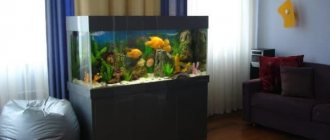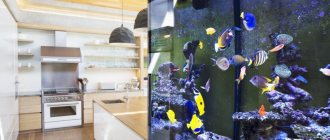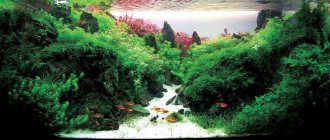An aquarium is nothing more than a body of water in miniature with its own laws and rules. Behind the external calm and tranquility lies an active life. Biological and chemical processes constantly take place here. The task of the aquarist is to achieve biological equilibrium or biobalance, when the waste products of all organisms in total (plants, fish, microorganisms) have time to break down and assimilate without harm to each other. We’ll talk further about how to achieve successful establishment of biological balance in an aquarium.
What is the nitrogen cycle and its importance for biobalance
Throughout their lives, fish and other aquarium inhabitants produce organic waste. Organic matter rots and produces ammonia. It is also secreted by fish during breathing. This is an extremely toxic element. It can lead to the death of all living things in a closed ecosystem. The ammonia content in water encourages the growth of bacteria. As a result of their activity, the harmful and dangerous element is converted into nitrites and then into nitrates. Nitrates are an excellent fertilizer for plants. Plants happily eat fish and other living creatures.
The process of ammonia breaking down into nitrites and nitrates, or the nitrogen cycle, is often referred to as new aquarium syndrome, but this process occurs constantly in the aquarium environment. It’s just that there is no established ecosystem in the new one, so the nitrogen (ammonia) cycle has an abrupt nature and can ruin the life of the owner, adding new worries.
Impact on humans
An aquarium, as a small artificial ecosystem, is very easy to maintain, which is why aquariums, called anti-stress aquariums, are often installed in long-term waiting areas. A closed ecosystem behind glass is an excellent way to calm down and relax.
Psychologists advise installing aquariums for anyone who is prone to anxiety. Calm contemplation allows you to quickly restore your performance and relieves emotional stress.
There are also more obvious physiological effects - evaporating water humidifies the air, which means it makes it easier to fall asleep. In children, caring for aquarium fish awakens a sense of responsibility, and watching them helps creative development.
Five important factors of biological balance (biobalance)
Soil as an element of biobalance
This element of the aquarium environment is an important component for all inhabitants. The soil is not only a decorative element of the aquarium, giving the aquarium a beautiful appearance.
Soil also affects the pH of the aquatic environment and prevents the accumulation of toxic substances. But the most important thing is that in the soil, along with the aquarium filter, live those very desirable aerobic nitrifying bacteria that contribute to the successful functioning of the nitrogen cycle.
One of the signs of problems with the soil: its inhabitants evacuate onto plants or glass. If you notice the movement of mollusks that usually live in the ground, urgently take measures to resuscitate the aquatic environment.
Filter as an element of biobalance
Here, water purification and improvement takes place: the destruction of organic waste, chemicals and toxic compounds. It is in the aquarium filter that most of the aerobic nitrifying bacteria settle, which convert harmful ammonia into relatively safe nitrates.
Therefore, the larger the sponge in the filter, the more beneficial bacteria will settle in it, and therefore the biological balance will be as stable as possible. To maintain the balance of the environment, the filter must work even in a crystal clear aquarium 24 hours a day.
Plants as an element of biobalance
The role of vegetation is by no means only decorative. Living plants feed on carbon dioxide, which is released by fish and other inhabitants of the aquatic space, thereby enriching the water with oxygen necessary for fish to breathe.
Participation in cleaning the aquarium environment makes plants a very important element of an artificial reservoir and the biological balance in it. The fact is that plants remove nitrates from the water, which, in the absence of plants, can only be gotten rid of by periodically changing the water in the aquarium.
Bacteria as an element of biobalance
These important residents of a closed small reservoir cleanse the aquarium of plant decay products and fish waste, converting toxic ammonia and ammonium first into no less toxic nitrite, and then into nitrate, which is poisonous only in large quantities. Nitrifying bacteria are an aerobic organism that requires oxygen dissolved in water.
This is why aeration must be present in the aquarium for stable biological balance. In addition, only with access to oxygen is it possible for oxidation of organic substances in the aquarium (residues of food, fish waste, rotten plant leaves, etc.). In the absence of oxygen, beneficial aerobic nitrifying bacteria are replaced by unsafe and harmful anaerobic bacteria, which produce hydrogen sulfide, which is life-threatening to aquarium inhabitants.
The influence of the volume and number of inhabitants on the biobalance in the aquarium
The biobalance in an aquarium directly depends on its size. If the aquarium is too small for the fish, then creating a favorable atmosphere simply will not work. In addition to fish, plants and bacteria live here. There should be enough space for them all to coexist safely.
If the volume does not correspond to the number of inhabitants or their size, the ecosystem will begin to limp. Bacteria will not cope with their task and will not be able to clean the water from the products of fish and plants. That is why it is recommended to buy an aquarium with a volume of at least 30-50 liters, since in aquariums of a smaller volume (so-called nanoaquariums) it is more difficult to achieve a stable biological equilibrium of a closed biosystem.
Ecological groups of organisms
There are three main groups of organisms:
- Producers are producers.
- Consumers are consumers.
- Decomposers are destroyers.
Producers are mainly plant organisms. This also includes some types of cyanobacteria. Manufacturers create organic matter. How do they do it? Using photosynthesis. In plants, mineral silt produces organic substances that the plant uses for growth and development. Therefore, the ecosystem in the aquarium is not left without food. You can notice that even with a sufficient amount of food, the fish still eat the algae - because this is their natural behavior.
The second group is consumers. This includes virtually all animals that eat plants or other animals. Those who eat plant foods are called first-order consumers. They are eaten by second-order consumers, and so on. Typically, aquarists do not keep second-order consumers together with herbivores - few people want fish to eat each other.
Destroyers are mostly fungi and bacteria. In addition to them, snails and catfish that clean the walls can be considered destroyers in the aquarium. Destroyers are needed to process waste and dead organic matter. If they did not exist, the water would quickly become polluted.
Thus, within the aquarium, the artificial ecosystem is organized in accordance with basic ecological rules. The closed aquarium ecosystem is imperfect and therefore requires human support.
Biobalance in a new aquarium
Unlike a natural body of water, an aquarium is a closed ecosystem. It is very easy to upset the balance in it. To create a favorable atmosphere for all inhabitants of an enclosed reservoir, it is important not only to maintain balance, but also to start it correctly. Starting an aquarium is not an easy task for a professional, but for a beginner it is a very serious test.
Approximate sequence of actions when starting an aquarium
The first day. We install the aquarium, lay the soil, pour water. It is important to let the water settle.
Day four . Turn on aeration and filter.
Day six. We plant plants.
Day nine . Let's launch the snails. The nitrogen cycle is accelerating.
Day fourteen . Let's launch the first batch of fish. At this stage, nitrite levels increase significantly. Bacteria multiply intensively and convert them into nitrates. The conversion of ammonia into useful substances receives a closed cycle. A biobalance of the environment of the new aquarium is created.
Day thirty . We release the remaining fish for which a safe environment is ready.
Advice . When starting a new aquarium, professionals advise using water from the fish’s old home. An element of an established biobalance will help to significantly speed up the process of creating balance in a new aquarium.
Read more about the technical features of launching a new aquarium in the article Stages of installing (launching) an aquarium
Aquarium Features
Sizes and shapes vary depending on its purpose. In houses, rectangular or bowl-shaped vessels are most often installed - fish are better visible in them.
There are several types according to their purpose:
- For raising fry. Afterwards they are transplanted into aquariums for adult fish.
- Decorative – intended for installation in public places and residential premises. They can be of different shapes and sizes.
- Quarantine – for keeping sick fish until recovery. Experienced breeders also place newly acquired fish in them to make sure that they are not sick.
- Spawning areas - fish spawn in them. The fry are then transferred to a special aquarium.
There are other varieties - for example, breeding aquariums and jigging aquariums.
As for the form, the choice depends on the purpose. A round vessel is great for decoration - but its volume is small, and the number of types available to contain is limited. You can keep swordtails, molynesias, and guppies in it. Other species will survive, but most likely will not breed in close quarters. In addition, it is difficult to install additional equipment in a round bowl. Another problem is light distortion, which negatively affects the behavior and health of fish.
The most popular is rectangular. The volume depends on the number and types of fish. Before purchasing, it is better to consult with an experienced aquarist.
How to speed up the launch of a new aquarium. Preparations to accelerate the establishment of biobalance in the aquarium
Establishing biobalance when starting a new aquarium requires a lot of patience and a lot of time. Manufacturers recommend specially developed products to quickly create balance. The following preparations contain cultures of nitrifying bacteria, allowing you to speed up the start of a newly launched aquarium.
So, to speed up the creation of biobalance in the aquarium, you can use special means.
1. AQUAYER Biostarter is a Russian-made product
Used in new aquariums or in case of disturbances in the biobalance in old ones.
Beneficial actions: reduces the amount of ammonia and nitrate through bacterial growth.
Advantages: the most important advantage is the short shelf life (six months). During this time, the drug does not lose its properties, unlike foreign analogues.
Application: shake the bottle, add the drug at the rate of 1.3 ml per 7 liters, apply daily for seven days in the amount of 0.5 of the first dose. Overdose is impossible.
2. Tetra SafeStart
Tetra SafeStart contains specially grown live nitrifying bacteria that significantly reduce the amount of harmful ammonia and nitrites in the aquarium. Reduces ammonia levels by up to 14 times, and nitrite levels by up to 10 times.
Can be stored for 12 months without refrigeration at temperatures between 2°C and 30°C. For all freshwater aquariums.
Application: Shake the contents of the bottle well and add 5 ml of product per 6 liters of aquarium water.
3. Sera Bio Nitrivec
Used for the rapid launch of aquariums.
Beneficial actions: reduces the level of ammonia and nitrites, prevents their accumulation.
Advantages: it acts instantly, fish can be released into the aquarium a day after using the drug .
Application: weekly at the rate of 10 ml per 25 l.
What is a biotope aquarium?
So, a biotope aquarium is a natural ecosystem of some reservoir, created artificially with strict adherence to all its conditions, from chemical parameters to filling and appearance. Simply put, this is an exact copy of the water area, artificially created in the aquarium.
What is it like, a biotope aquarium?
Before creating a biotope aquarium, it is necessary to study the area of the reservoir in detail. And this, although painstaking, is no less interesting work. There are many streams, swamps, lakes, and rivers all over the planet. Each area, each depth segment, can have its own biotopes, very different from each other.
Note ! From the human perspective, a biotope aquarium, of course, should look harmonious and aesthetically pleasing. But the main rule is to collect as much information as possible about the area of the planet that you want to obtain.
A biotope aquarium is an artificially created aquatic ecosystem
It is worth remembering that some aquariums are only partially biotopes:
- species aquarium . Designed, as you might guess from the name, for a single species without reference to the area or to a specific biotope;
- ecological aquarium . Attached to living conditions, not to terrain. Designed to create a beautiful aquarium garden;
- geographical aquarium. Tied to a specific area. Designed to recreate the necessary conditions for fish located in the same geographical area.











